The crypto market downturn explained: a macro outlook
The crypto market downturn explained
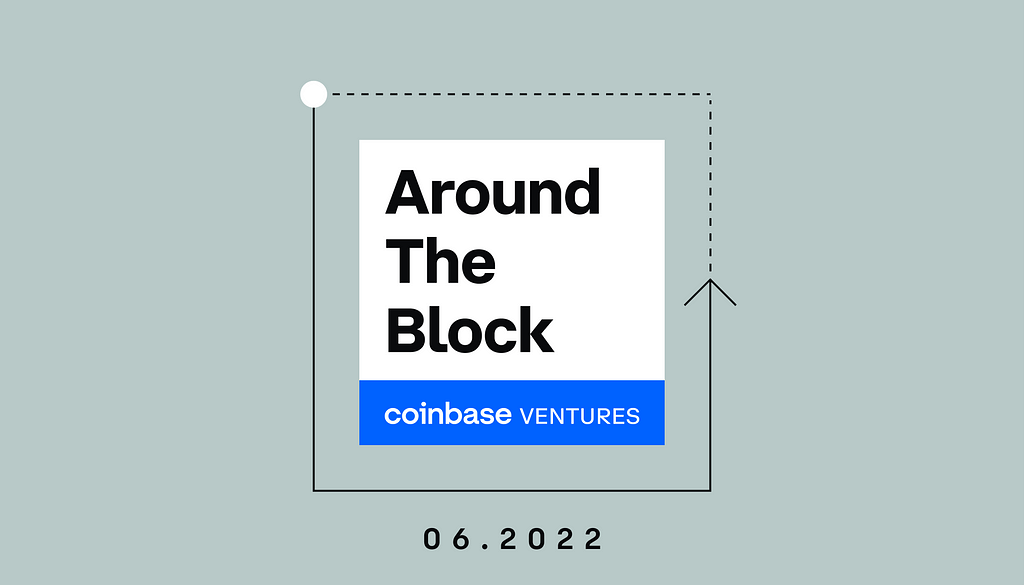
Around the Block from Coinbase Ventures sheds light on key trends in crypto. Written by Connor Dempsey. Data by Mike Cohen.
TLDR:
- Central Banks and governments responded to the March 2020 COVID market shock with unprecedented interest rate cuts, money printing, and stimulus
- These easy money policies kicked off a multi-year bull run for equities and crypto, before eventually causing inflation that was further exacerbated by COVID supply shocks
- BTC, ETH, the NASDAQ, and S&P each peaked at the tail end of 2021, when it became clear that inflation was not under control and that Central Banks would have to unwind the same policies that propelled stocks and crypto to new heights in the first place
- This cycle crypto has been broadly correlated with tech stocks, and has traded like risk assets
- While not immune to Central Bank policy in the short run, the prospects of crypto and Web 3 in the long run remain stronger than they’ve ever been
Financial markets are, in essence, one giant information processing machine. A machine that responds to new information not directly, but as it affects the decisions of millions of individual buyers and sellers. Or as Benjamin Graham famously put it, “in the short run, the market is a voting machine.”
With the S&P 500, NASDAQ, BTC, ETH, and most crypto assets significantly off of their all-time-highs, that begs the question: what information has market participants predominantly voting to sell?
In this edition of Around The Block, we take a look at the overall macro downturn with an eye towards the crypto markets.
As of June 2022, US equities have shed roughly 20%, or $10 Trillion in value. For US stocks, the selloff has not yet approached the severity of other historically noteworthy downturns, but it’s certainly in the conversation.
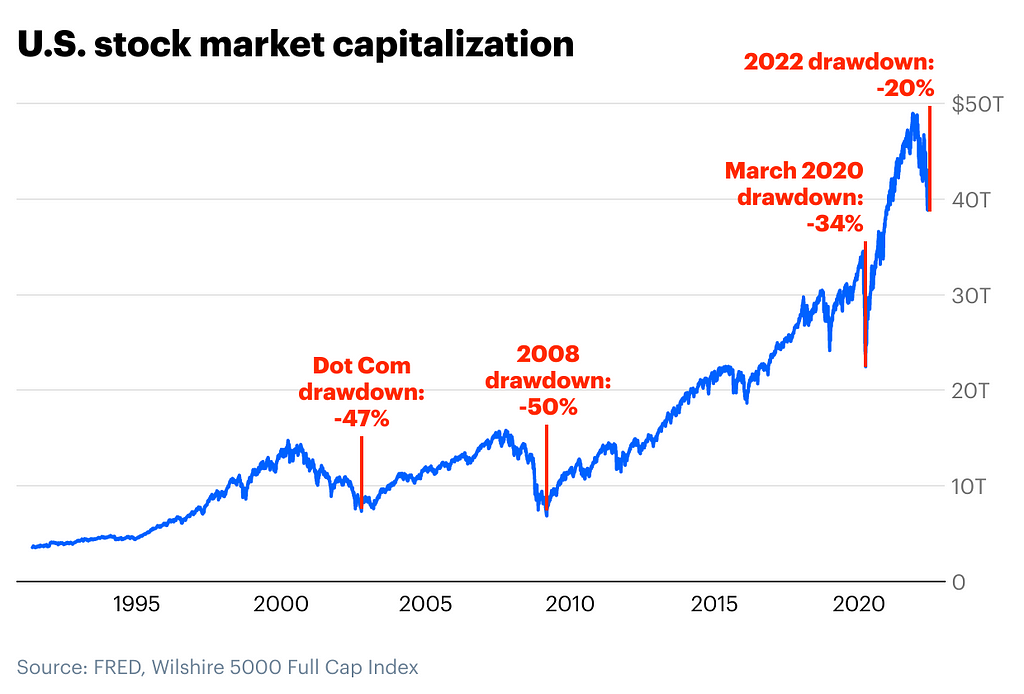
Crypto meanwhile, has shed nearly 60%, or $1.7 Trillion. For comparison, it shed 87% of its total market cap after the peak of the 2017 bull run.
BTC, ETH, and the NASDAQ all peaked in November, with the S&P 500 peaking at the end of December. So what changed during the last two months of the year? To understand this market downturn, it’s helpful to start at the beginning of a historic bull run that both stocks and crypto experienced in 2020.
Entering 2020, Bitcoin was rallying from the depths of the 2018/19 crypto winter, from $7,500 to nearly $10,000. Meanwhile the S&P and NASDAQ each stood at all-time highs. Then COVID hit.
COVID shock of March 2020
On March 12, 2020, the World Health Organization declared the Coronavirus a pandemic and governments around the world placed entire countries on lockdown.
As the magnitude of COVID-19 set in, it became clear that our global economy was not adequately prepared to handle the shock, sending all markets into a panic. The S&P and NASDAQ each declined around 30%, with crypto markets getting hit harder (in absolute terms). When the dust settled, BTC briefly dropped below $4,000, shedding over 60% of its value.
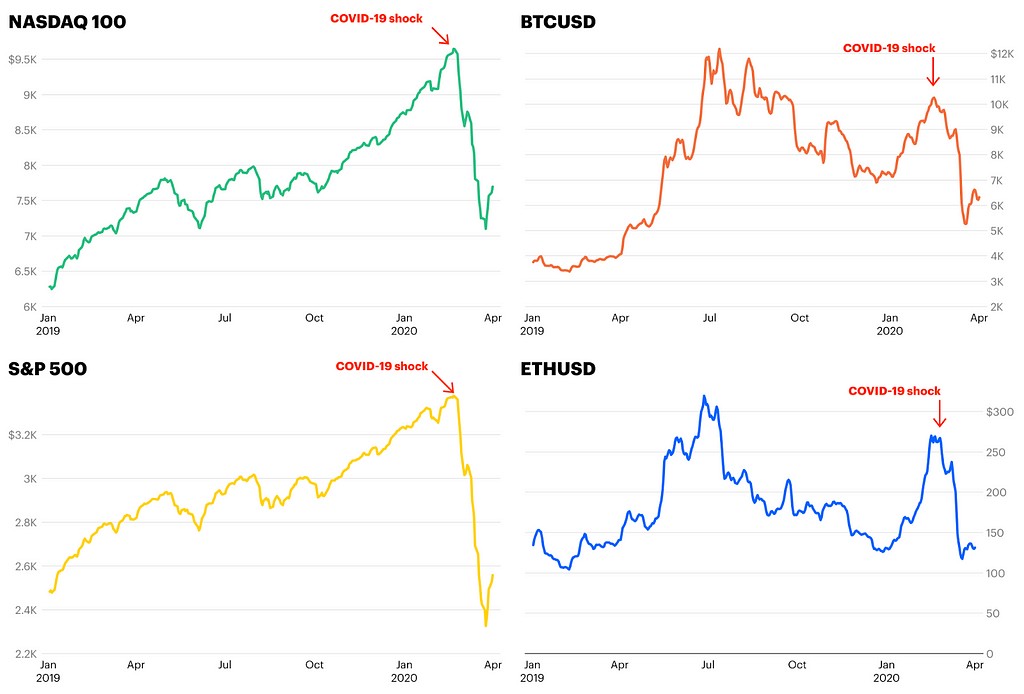
In short, COVID sent panicked investors to rush for the safety of cash, sending all liquid markets down sharply. Then the US Federal Reserve stepped in.
The Fed response
As the Central Bank behind the world’s largest economy, the US Federal Reserve plays a unique role in financial markets. Mainly, it controls the supply of the US dollar, which is the world’s reserve currency.
The money printer and interest rates are the Fed’s main tools for supporting the economy in times of extreme turmoil. By digitally printing money and buying financial assets like bonds from financial institutions, they can introduce new money into the economy. By lowering interest rates, they can make it cheaper for other banks to borrow money from the Fed, which also introduces new money (in the form of credit) into the economy.
After COVID, the Fed dropped the cost that banks pay to borrow money from the Central Bank, known as the Federal Funds Rate, to essentially zero. This allowed banks to, in turn, lower the cost at which their customers borrow money. These cheap loans could then be used to finance homes, businesses, spending and other investments.
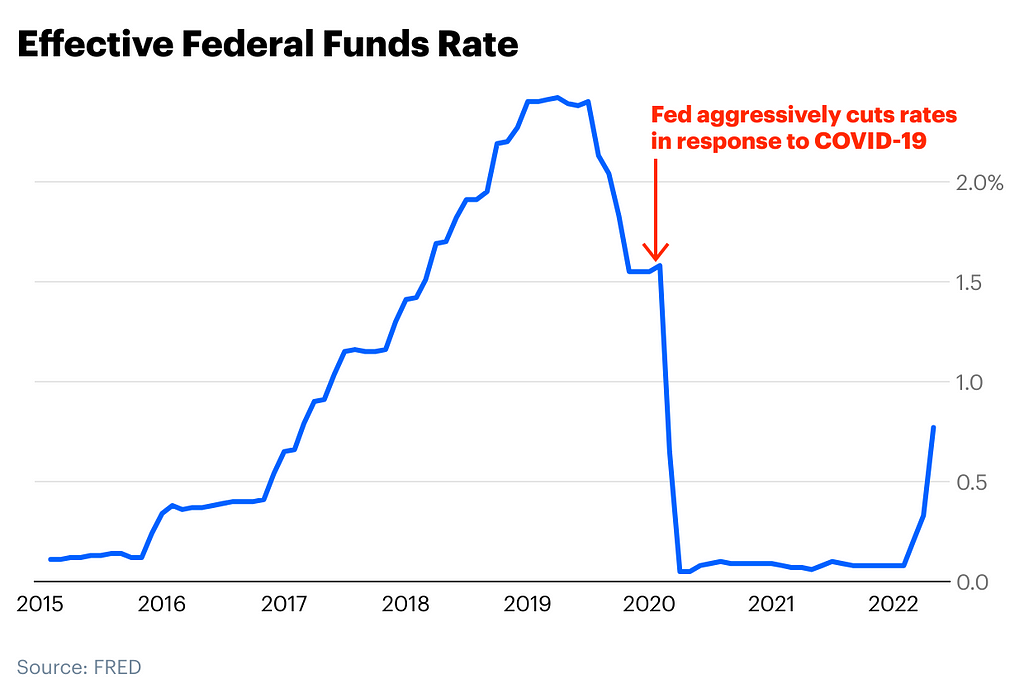
By digitally printing new money and using it to buy treasury bills and other securities from financial institutions (this is known as quantitative easing), an unprecedented amount of US dollars was introduced into the economy. Over the next two years, almost 6 trillion in new money was printed, increasing the broad supply of USD nearly 40%. Awash with cash, financial institutions compete to lend this fresh capital out, forcing them to lower interest rates to remain competitive. Again, availability of cheap credit encourages borrowing, which ultimately supports the economy.
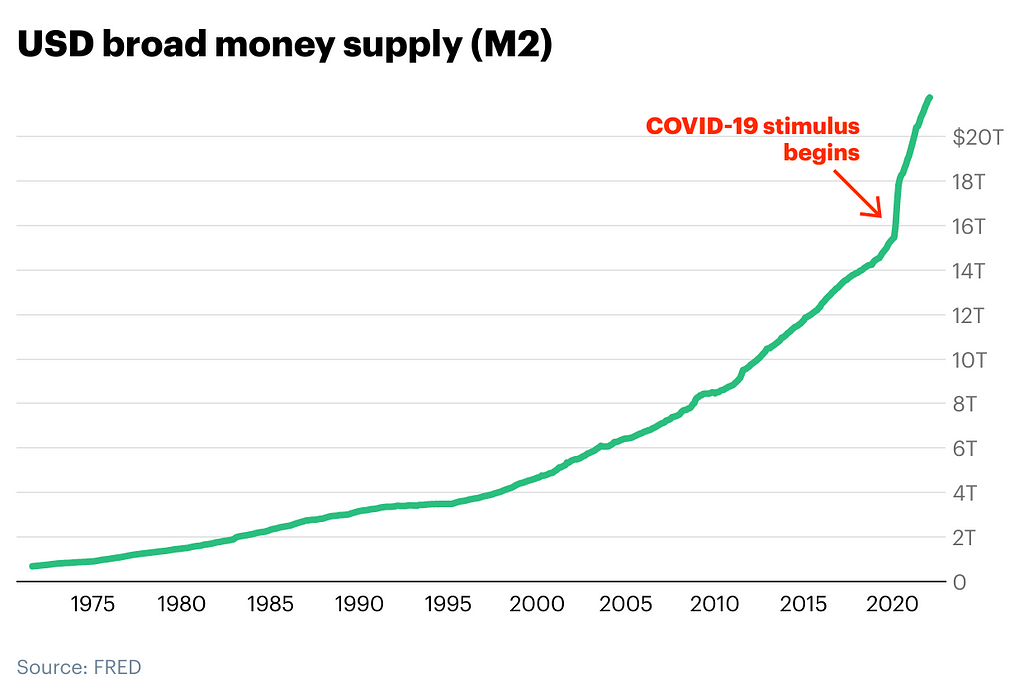
The US wasn’t alone, as the European Central Bank, Bank of Japan, and Bank of England all lowered interest rates to near (or even below zero) and printed money at historic levels. All told, the world’s four major central banks printed $11.3 trillion, which is a 73% expansion since the beginning of 2020.
On top of all that, the US Government injected over $5 trillion of “stimulus” into the economy by taking on debt from public, private, and foreign entities. Similarly, China pumped another $5 trillion into its economy through the same methods. Basically, the world became awash with fresh cash.
Don’t fight the Fed
“Don’t Fight the Fed” is an old investor mantra which implies that given the Fed’s outsized influence, one should invest in lockstep with whatever direction the Fed is moving financial markets. This mantra rang true after COVID struck in 2020.
When new money is being printed at record levels, and interest rates are near zero, all of this money and credit needs a place to go. On top of that, when rates are low, conservative instruments like bonds are less profitable, pushing money into higher yield assets. In the aftermath of COVID, these forces caused massive inflows into stocks, crypto, and even NFTs, helping push asset prices to new heights.
From their COVID panic induced bottoms, the S&P500, NASDAQ, BTC, and ETH would soar 107%, 133%, 1,600%, and 4,200% respectively.
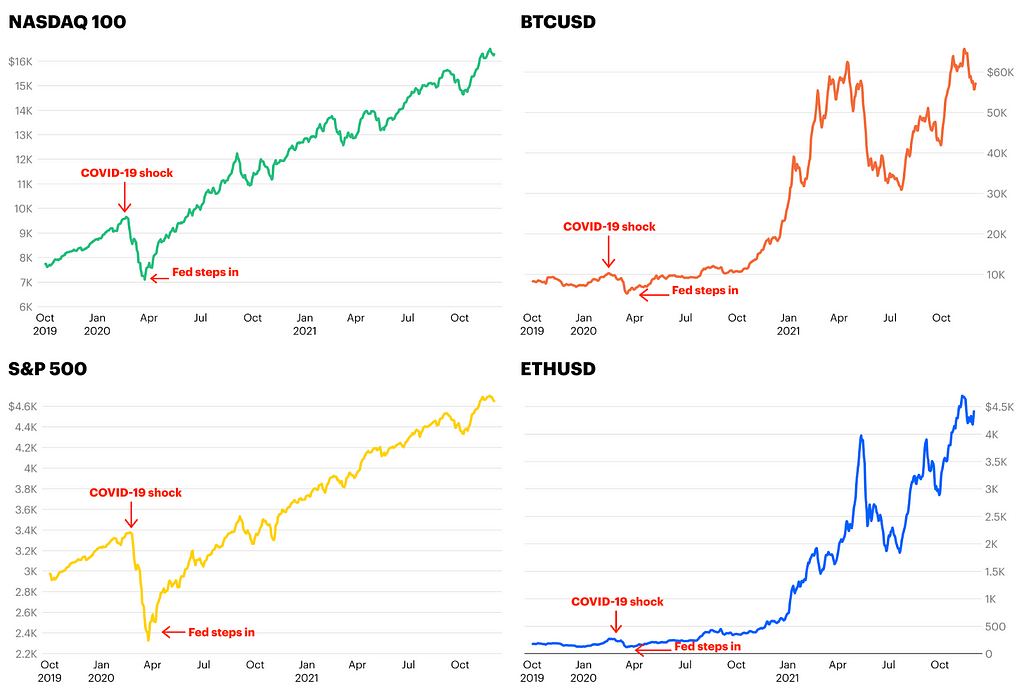
Enter inflation
When the system is awash with money, and assets are going up, everyone feels richer. People can spend more and companies can pay their employees more. When spending and incomes increase faster than the production of goods, you have “too much money chasing too few goods,” and the price of goods rise, or inflate.
With supply chain shocks stemming from COVID lockdowns, there were even fewer goods in the economy. More money chasing even fewer goods led to even more inflation. This started to become apparent in May 2021.
The consumer price index (CPI) measures the change in prices paid by consumers for goods like gas, utilities, and food. From March to May 2021, it shot up from a healthy 2.6% to 5%. By March 2022 it hit 8% — levels of inflation not seen in over 40 years.
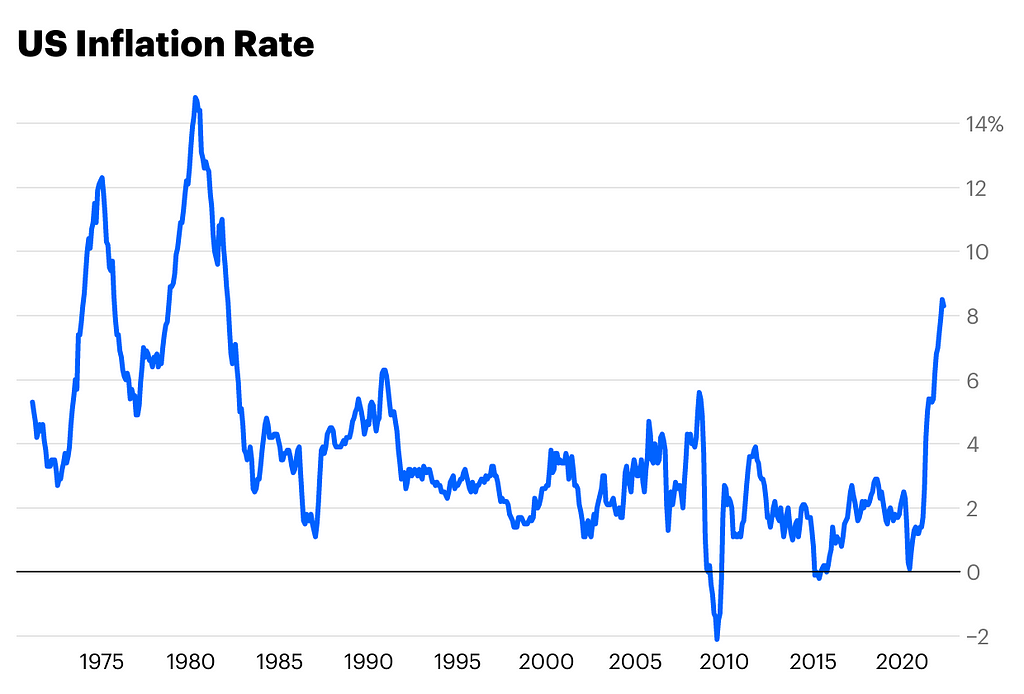
Inflation makes everyone poorer, because people’s money no longer buys as much as it once did, so the Fed had to step in once again. To combat rising inflation, they turn to the same tools they used to support financial assets in the first place.
Reversing course
As we explained, low interest rates and newly printed money support both the economy and asset prices. When overdone, they can also lead to inflation. When that happens, the Fed flips the switch, raises rates and removes money from the market, setting the process in reverse.
Raising interest rates ripples throughout the economy. Since it makes it more expensive for banks to borrow from the Central Bank, they in turn charge customers more to borrow money. On top of it becoming more expensive for everyone to borrow money, the price to pay for money already borrowed also goes up (think if your credit card rate jumped from 5 to 10%).
Where quantitative easing involves injecting money into the economy by buying securities from financial institutions, quantitative tightening is the opposite. First, the Fed stops buying securities while letting existing securities expire, and eventually, begins selling them on the open market. This ultimately leads to less money in the economy. Less money to lend out causes interest rates to rise due to simple supply and demand.
With the cost of borrowing and paying existing debts more expensive, everyone slows down on the spending that caused inflation in the first place. With less money being pumped into the economy via asset purchases, there’s less money chasing inflated goods, and prices in theory should normalize. There’s also less money chasing investments, which brings the price of assets down along with it — something sophisticated market participants know all too well.
The machine reacts
When inflation was hanging around 5% over the summer, the line out of the Fed was that it was “transitory,” or non-permanent. On November 3rd, 2021, the Fed said that it would start to slow asset purchases, but would be patient with any interest rate hikes as it continued to monitor inflation.
When October’s CPI of 6.2% was announced on November 10th, it became clear that inflation was not under control and that the Fed would have to intervene. While the first interest rate hike wouldn’t come until March, the great information processing machine that is the market, seemed to react at first sign that they’d likely be coming.
Don’t fight the Fed rang true once again, as BTC and ETH each peaked on November 8th, the NASDAQ on November 19th, and the S&P at the end of December.
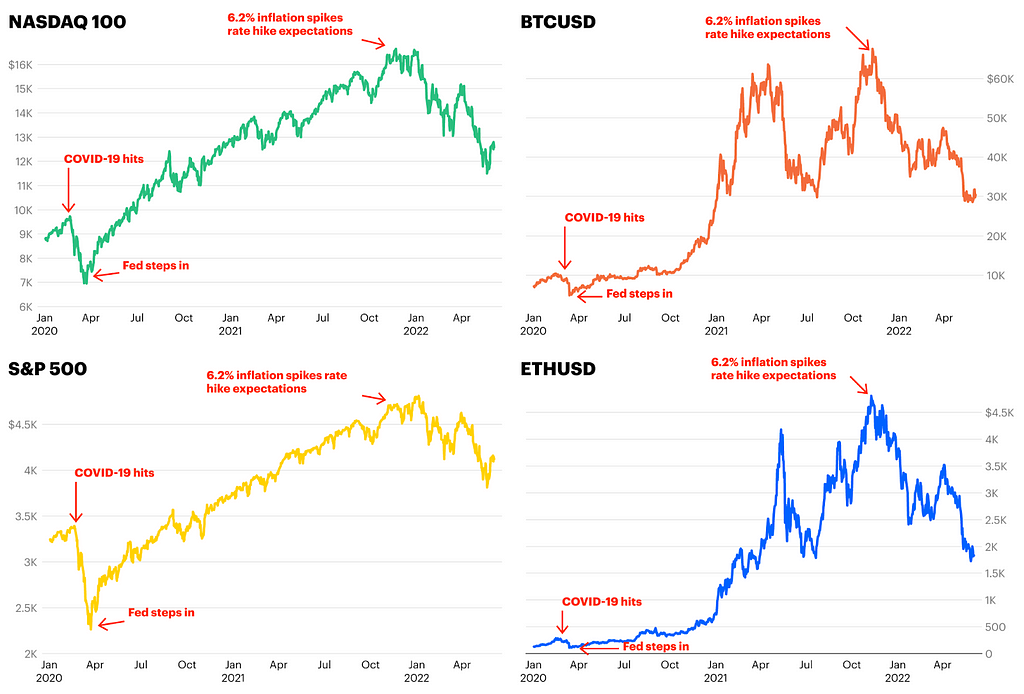
Even the CryptoPunks floor price (a proxy for NFT sentiment) and DeFi TVL peaked during this same period.
In a nutshell
Basically, in response to COVID, Central Bank and government intervention helped keep markets afloat with record low interest rates, money printing and stimulus. These easy money policies ultimately helped propel stocks and crypto to all-time highs before leading to inflation — inflation that was exacerbated by supply chain stocks stemming from COVID lock downs in China (and later on in 2022, Russia’s invasion of Ukraine).
When it became clear that inflation was persistent and that Central Banks would have to reverse course and bring an end to the policies that propelled many assets to new heights, the macro downturn began.
The great re-rating
While we started our story at the beginning of 2020, the era of easy Central Bank monetary policies started in the wake of the 2008 Great Financial Crisis. An era that saw the birth of crypto as well as a historic run in equities.
In the face of inflation not seen in 40 years, Central Banks have signaled that the easy money era has come to an end. Previous frameworks for valuing companies and assets are no longer relevant in lieu of this shift. The value of everything has been “re-rated”, which is the downturn we’ve all experienced over the course of the last six months.
When interest rates rise, bonds become more attractive investments. Meanwhile, “growth” stocks, or companies that aren’t expected to produce dividends until many years in the future get hit the hardest. With money tighter, investors preferences shift to investments that produce cash flows today, rather than far out in the future. Thus the tech sell-off.
Crypto selloff
But wasn’t crypto supposed to be an inflation hedge? It depends. If you bought Bitcoin in May 2020 after macro investor Paul Tudor Jones famously dubbed it “the fastest horse” in a post COVID environment, you’re still up over 200% and well ahead of inflation. If you bought after inflation started to rear its head, much less so.
Even with the correction, Bitcoin and ETH are each still up 500% and 1,000% respectively from their pandemic lows. Longer tail assets have not fared as well, however, and it’s hard to deny that this time around crypto more broadly has been highly correlated with stocks — particularly tech.
Tech stocks are considered risk assets. Given the correlation, it’s fair to say that most individuals are still treating crypto similarly. Risk assets carry high upside, as well as high downside risk. When money gets tight, which is what happens when Central Banks tighten up, risk assets are often the first to get sold. That, in a nutshell, explains the recent crypto market downturn.
The Fed giveth
Have you ever wondered why market participants hang on every word of the Fed Chair? It’s because they know that the direction in which the Fed turns its dials can significantly influence markets and the economy. It can make businesses succeed or fail, and home values rise or fall.
It’s not done with malice, but with the noble aim of keeping prices stable and people employed. However, the Fed’s tools are somewhat crude, and in the hands of well meaning, but inherently fallible groups of people. It isn’t unreasonable to think it strange that the unilateral decisions of a very small group of people remain so consequential for the average person.
While crypto prices are clearly not immune to Fed policy, it should also come as no surprise that it was among the best performing asset classes over this last market cycle. Easy money policies encourage speculation, and speculation has always accompanied paradigm shifting technologies: personal computers, the internet, smartphones, and even the railroads of the 1800’s.
Additionally, Bitcoin and its hard supply of 21 million that can’t be debased by a central authority continue to stand in stark contrast to Central Bank money printers. History tells us that all centrally managed currencies fail eventually, typically from mass inflation via economic mismanagement. While this cycle has also shown that crypto is still far from without its risks and shortcomings, it also further validated the need for decentralized systems free from the risks of single-party control to co-exist with centralized counterparts. While crypto prices will remain influenced by Fed policy in the short run, in the long run, crypto and Web3 remain more alluring than ever.
Looking ahead
If this is your first crypto market downturn, it can certainly be scary. It is however, not without precedent. This market has been pronounced dead in 2018, 2015, and 2013, only to come back stronger each time.
Like the internet before it, crypto innovation marches on regardless of market cycles.
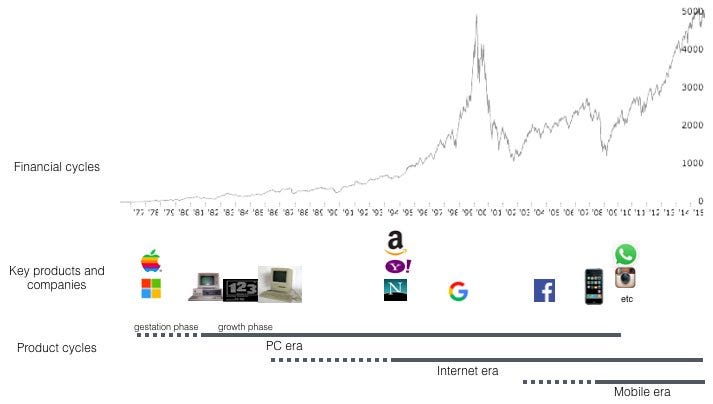
From our seat, crypto feels more inevitable than it’s ever been. Bitcoin has global adoption, now held by institutions, corporations, countries, and millions of individuals alike. DeFi has created the underpinnings of an internet based financial system with no single party in control. The foundations for Web3 and a user-owned internet have been laid. NFTs have birthed billion dollar industries across art and gaming with a diverse array of use cases on the way. DAO treasuries manage nearly $10B+ and are just getting started. Crypto’s real world utility has been showcased on the world stage, raising millions in aid for Ukraine following a Russian invasion.
Even the biggest detractors have come around. 9 out of 10 Central Banks are exploring digital currencies and analysts at JP Morgan have dubbed crypto a “preferred alternative asset class.” Facebook rebranded to Meta, Twitter, Spotify, TikTok and Instagram are integrating NFTs, while Google and Microsoft are each dipping their toes into Web3.
In the long run, it appears that the proliferation of the financial internet is a function of time, rather than Central Bank policy.
The weighing machine
As we mentioned, Benjamin Graham said that in the short run, the market is a voting machine. But he also said that in the long run it is a weighing machine. In the short run it’s a giant information processing machine subject to emotional swings when presented with distressing information. In the long run, it has a knack for weighing assets based on their true value.
Bitcoin and Ethereum have maintained their weight over past downturns. Many other crypto assets will be weighed accordingly over the current downturn. The job of the individual is to vote in the short run for whatever they think the market will weigh as valuable in the long run.
At Coinbase, our votes are cast on crypto, Web3, and the financial internet eventually being weighed as one of the most valuable innovations of our time.
Special thanks to Scott Meadows, David Duong, and Griffen McShane for the review!
This website does not disclose material nonpublic information pertaining to Coinbase or Coinbase Venture’s portfolio companies.
Disclaimer: The opinions expressed on this website are those of the authors who may be associated persons of Coinbase, Inc., or its affiliates (“Coinbase”) and who do not represent the views, opinions and positions of Coinbase. Information is provided for general educational purposes only and is not intended to constitute investment or other advice on financial products. Coinbase makes no representations as to the accuracy, completeness, timeliness, suitability, or validity of any information on this website and will not be liable for any errors, omissions, or delays in this information or any losses, injuries, or damages arising from its display or use. Unless otherwise noted, all images provided herein are the property of Coinbase. This website contains links to third-party websites or other content for information purposes only. Third-party websites are not under the control of Coinbase, and Coinbase is not responsible for their contents. The inclusion of any link does not imply endorsement, approval or recommendation by Coinbase of the site or any association with its operators.
The crypto market downturn explained: a macro outlook was originally published in The Coinbase Blog on Medium, where people are continuing the conversation by highlighting and responding to this story.
9 June 2022 13:51